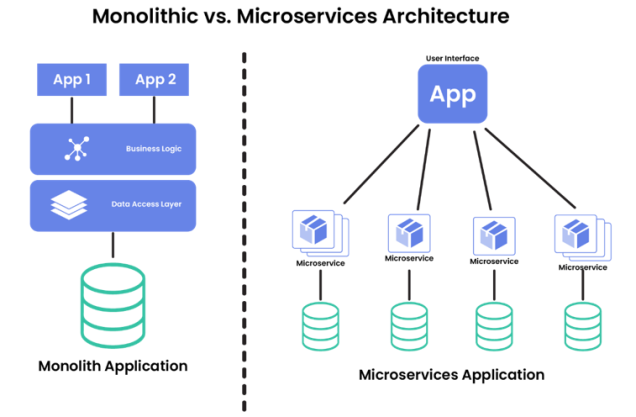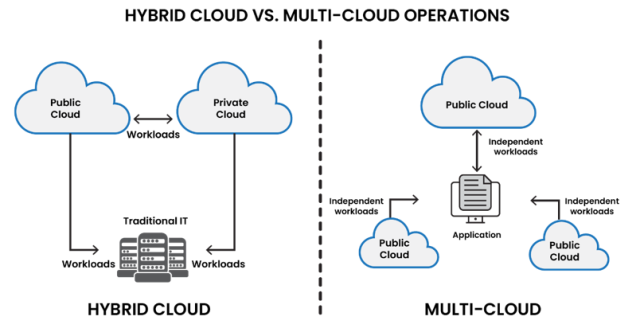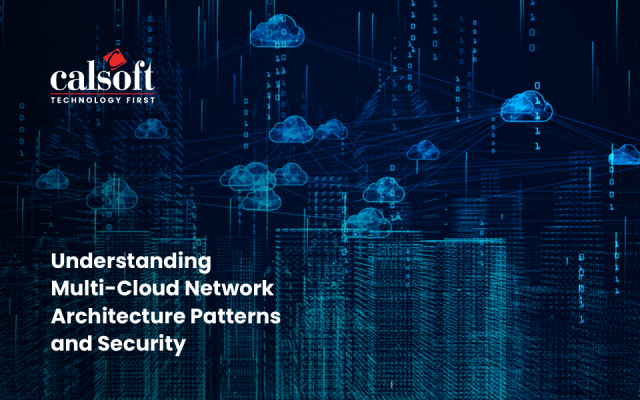Why should businesses care about microservices? A short and crisp answer to this question can be powerfully summed up in four sentences.
Migrating from a monolithic architecture to microservices has the potential to affect several factors responsible for the growth and seamless operations of any organization. This includes improved efficiency, scalability, and agility. By adopting microservices, businesses have the upper hand. They can boost team productivity, gain faster deployment times, enhance fault acceleration, and more in a cost-efficient way and the credit goes to microservices.
Apart from this, there are several other advantages of moving from a monolith to microservices. Well, teams often go for this option when they tend to run into one or more challenges listed below:
- The monolithic application gives a tough time to scale with increase in codebase complexity.
- The next situation is when businesses are unsure about reliability in the monolithic setup because failure in one component can be catastrophic as it can take down the entire system.
- The monolithic structure creates a waterfall style of application development, ultimately reducing the developer’s velocity.
Microservices have soared in terms of popularity and adoption in recent years. The rise of this architecture in the past has been nothing less than a whirlwind rise. Data from the O’Reilly survey states that 77% of businesses reported the adoption of microservices and around 92% of these state that the adoption has been a successful affair.
Meanwhile, the IBM report focused on microservices in the enterprise, found many benefits associated with moving to a microservice architecture, that ranged from better customer retention and data security to greater flexibility and employee productivity.
But alongside this shift, there’s another trend gaining momentum: the rise of hybrid and multi-cloud strategies. Businesses are increasingly adopting multiple cloud platforms to avoid vendor lock-in, enhance flexibility, and optimize their workloads across different environments. This approach is becoming a key factor in driving innovation and resilience.
Keeping in mind the gravity of combining microservices with a hybrid and multi-cloud setup, businesses need to take this up more strategically. Remember, striking the right balance with these technologies can unlock greater scalability, flexibility, and efficiency for businesses.
However, to simplify the deployment of microservices in a hybrid and multi-cloud environment and boost success rates, our blog is focused on building a strong background and delivering the key strategies to ensure better resource management across diverse environments.
So, let’s get started!
Decoding Monolithic Architecture and Microservices: An In-Depth Overview

The image contrasts Monolithic and Microservices application architectures. On the left, a Monolithic application centralizes components like business logic and data access, whereas on the right, a Microservices architecture distributes functionalities across independent services, each with its own database, promoting flexibility and scalability in software development.
What is Monolithic Architecture
A monolithic architecture is nothing but a traditional software program model, constructed as a unified unit self-reliant and distinct from other applications. As the name suggests, monolithic architecture is a single and large computing network with just one code base that combines end-to-end business concerns. Monolithic architecture can work well during the early stages of a project by easing out elements like code management, deployment, and cognitive overhead.
On the other hand, it is also important to know that Monolith is quite clumsy when it is time to make any changes, this type of application demands an update of the entire stack by accessing the code base and building and deploying an updated version of the service-side interface.
What are Microservices
Microservices indeed are a more efficient way to approach application development. A microservice is nothing but a cloud-native way of building software in a manner that enables each of the core functions within an application to exist independently. Primarily, microservices refer to a style of application architecture where a collection of independent services is engineered to communicate via lightweight APIs.
On the bright side, when elements of an application are separated in such a manner, it gives more room for development and operations teams concurrently without having to depend on or get in the way of one another.
Demystifying Microservices: Core Concepts
| Core Concept | Description |
| Decentralized Governance | Microservices emphasize decentralized governance, allowing teams to choose the right tools and technologies for each service. |
| Componentization via Services | Microservices are designed as individual components (or services) that can be independently developed, deployed, and maintained. |
| Smart Endpoints, Dumb Pipes | Each service is responsible for its logic and functionality, while communication between services is kept simple, often through APIs or messaging systems. |
| Decoupling of Services | Services are loosely coupled, ensuring minimal dependency, which allows for easier scaling, updates, and maintenance. |
| Continuous Delivery | Microservices support frequent deployment of code changes, improving time to market and enabling quick iteration of features or fixes. |
| Scalability | Services can be independently scaled based on demand, ensuring optimal resource utilization across different parts of the system. |
| Resilience | Microservices are designed to handle failures gracefully. If one service fails, the others continue to operate, ensuring the system remains functional. |
| Autonomous Teams | Teams responsible for microservices can work independently on their assigned services without being dependent on other teams or parts of the system. |
| Technology Diversity | Teams have the freedom to use different technology stacks, frameworks, or languages for each microservice, depending on the problem they are solving. |
Navigating the Hybrid and Multi-cloud Landscape
Both hybrid and multi-cloud are cloud deployments that incorporate more than one cloud. However, the primary difference between the two is that hybrid blends two or more cloud types that are different from each other, whereas multi-cloud infrastructure is a combination of the same kind.

This image contrasts hybrid cloud and multi-cloud operations. A hybrid cloud integrates both public and private clouds, allowing workloads to move between them and traditional IT infrastructure. In multi-cloud, different public clouds are used independently for various workloads, with applications interacting with separate cloud environments without integration.
Describing Hybrid Cloud
A hybrid cloud combines public and private cloud environments, including on-premises data centers, to run applications and manage workloads. It offers flexibility, allowing businesses to migrate between environments based on their needs. Hybrid cloud solutions help reduce costs, minimize risks, and support digital transformation by integrating on-premises systems with cloud-based services.
Describing Multi-cloud
A multi-cloud infrastructure deploys multiple cloud providers such as Google Cloud, AWS, and Azure to distribute services and workloads. This cloud strategy helps businesses with aspects like flexibility, reduced vendor lock-in, and improved reliability by diversifying resources. All in all, a multi-cloud structure enables organizations to sign up for the best services from different cloud providers and work as a driving force toward enhancing the performance quotient and cost efficiency.
To get more grip on this topic you can also check out our blog on Understanding Cloud Infrastructure Services
Understanding What Gets Microservices Ticking
To begin microservices planning, IT teams must understand what makes microservices different from application components or elements of a service-oriented architecture. Microservices are not complete application pieces; they are designed to be shared, as services, among applications — meaning multiple apps can invoke a single instance of a microservice at the same time. Microservices are also designed to use web-like RESTful interfaces.
If microservices don’t fit the model above, they aren’t likely to deliver as many benefits. When microservices do match the characteristics above, you need to sustain each of them in a hybrid or multi-cloud deployment.
Deployment Strategies of Microservices for Hybrid and Multi-Cloud Environments
Design for Portability
Microservices should be containerized using tools like Kubernetes or Docker to ensure easy deployment across different environments. This enables flexible, hassle-free migration between cloud setups.
Leverage API Gateways
API gateways manage communication between microservices, routing client requests to the appropriate services. They centralize key functions like traffic routing, monitoring, and logging to ensure smooth operations across cloud environments.
Implement Centralized Monitoring
Centralized monitoring tracks microservices’ performance and health across multiple environments from a single platform. It helps quickly identify and resolve issues, ensuring smooth operations in hybrid and multi-cloud setups.
Adopt DevOps Practices
Implement CI/CD pipelines to automate deployments and updates across hybrid and multi-cloud environments, ensuring consistency and efficiency.
Ensure Security & Compliance
Implement cloud-agnostic security policies that cover identity management, data encryption, and access control across both private and public clouds.
Use Cloud-Native Tools
Opt for cloud-native tools like Kubernetes for orchestration and Istio for service mesh to handle the complexity of multi-cloud deployments.
Optimize Workload Placement
Strategically place microservices in the most suitable environment based on performance, cost, and compliance requirements, whether in public or private clouds.
Enable Cross-Cloud Networking
Ensure a robust networking solution to support communication between microservices deployed across different clouds, using technologies like VPNs or cloud interconnects.
Deploy microservices securely
The fact that multiple applications often share a single microservice can create two other challenges in hybrid and multi-cloud environments: security and compliance, and stateful vs. stateless behavior.
Any time applications share functionality, there’s a risk that an application with rigorous compliance requirements will be contaminated. This is because a shared service might provide outsiders with a portal for entry. Since moving microservices, or duplicating them under load, requires open addressing, you need to secure each microservice with respect to its access. Avoid microservices that mix features demanding security and compliance monitoring with other features open to a larger community — make them two different microservices.
Explore the stateful vs. stateless issue
The stateful vs. stateless issue is complex, even for software architects and developers. Applications typically support transactional activity that involves multiple steps or states. For example, imagine we have a service called “add two numbers.” If we present the first number on one request and the second on another, other users could inadvertently introduce their own number between our two, and we’d get the wrong answer.
Technologies & Tools for Microservices Deployment
Signing up for the right tools and technologies while deploying microservices is a must. The table below gives a quick overview of the tools, their description, and their purpose.
| Category | Tool | Description | Best Suited For |
| Containers | Docker | Containerization platform for packaging microservices. | Portable and scalable deployments. |
| Orchestration | Kubernetes | Automates deployment, scaling, and operations of containers. | Managing clusters across clouds. |
| API Management | Kong, Istio | API gateways and service meshes for managing microservices interactions. | Cross-cloud service communication. |
| CI/CD Pipelines | Jenkins, GitLab CI/CD | Tools for continuous integration and delivery. | Automating deployments. |
| Monitoring | Prometheus, Grafana | Monitoring and visualization tools for microservices. | Real-time performance tracking. |
| Load Balancing | HAProxy, NGINX | Ensures efficient load distribution across services. | Balancing traffic across environments. |
Impact of Microservices in Hybrid and Multi-Cloud Environments
Microservices offer significant advantages in hybrid and multi-cloud environments by enhancing flexibility, scalability, and fault tolerance. In a hybrid cloud, where businesses use both on-premises infrastructure and cloud services, microservices enable seamless distribution of workloads across platforms. Their independent nature allows organizations to deploy, manage, and scale specific services based on demand, fostering agility and operational efficiency.
By isolating potential issues within individual services, microservices also improve fault tolerance. If one service encounters a problem, it won’t disrupt the entire system, ensuring the application continues to function smoothly. Furthermore, microservices can accommodate diverse technology stacks, allowing teams to use the best tools suited for each environment.
In multi-cloud setups, microservices can face network performance challenges due to the division of applications into numerous requests for external services. These requests are made over networks, which may introduce propagation delays or other performance issues. Ensuring quality of service (QoS) becomes critical, and it’s essential to test microservice performance across all hosting variations. Poor network connectivity can degrade QoS, so organizations may need to adjust network infrastructure or design deployment strategies to avoid dead spots.
Network performance issues often stem from how traffic passes through clouds and data center boundaries. Public cloud providers typically don’t connect directly with one another, necessitating VPNs or data center networks to bridge the gap. This can result in significant propagation delays when an application in one cloud accesses a microservice in another. To prevent this, businesses may need to deploy duplicates of microservices across different clouds to maintain performance and avoid cross-cloud latency.
Finally, microservice movement between cloud providers or data centers can cause IP address changes, requiring updates to DNS or service catalog entries. Proper tools and practices must be in place to ensure seamless access to microservices, even after they change locations.
Challenges of Hybrid and Multi-cloud Architectures for Microservices
Hurdles are a part and parcel of life. Similarly, while deploying any technology non-existence of challenges is a myth. In short, no matter how good microservices are for hybrid and multi-cloud architecture, enterprises are bound to face challenges while implementing them. However, to be well-prepared, it is important to have an idea about what these challenges look like, to ultimately smoothen the process.
Hybrid and multi-cloud environments are known to offer a significant amount of flexibility and variety, but they come with their own set of challenges. The complexity and diversity that lies in these setups can create difficulties in managing various cloud platforms, services, APIs, tools, and configurations, potentially leading to issues with consistency, interoperability, and governance. Ensuring security and compliance across different cloud environments can be challenging due to differing policies, standards, and protocols. Performance and latency concerns may arise from the locations, availability, and bandwidth of cloud resources. Additionally, managing costs and optimizing usage can be tricky due to varied pricing models, billing cycles, and discounts, which might result in over-provisioning, under-utilization, or redundant resources, ultimately leading to inefficiencies and wasted expenses.
Mentioned below are top three challenges that businesses are likely to face while deploying microservices in the hybrid and multi cloud setup:
Increased Complexity in Management: Managing multiple cloud environments with different platforms and services can lead to operational challenges. Ensuring seamless integration, monitoring, and coordination across various cloud providers adds layers of complexity.
Data Security and Compliance: Ensuring consistent security policies and maintaining regulatory compliance across hybrid and multi-cloud setups is difficult. Varying data protection standards across cloud providers increase the risk of security gaps and vulnerabilities.
Latency and Performance Issues: Distributing microservices across multiple cloud environments can result in latency due to data transfer between clouds. This can impact performance, especially for applications requiring real-time processing.
Conclusion
Irrespective of the platform/architecture, microservices are a great way to build applications that are not a large single unit that is rigid. But it broke down into smaller services to make the system more agile and reduce the cost. Along with that, there are several ways businesses can benefit by embracing microservices. Right from scalability and fault isolation to faster deployment time, microservices offer significant advantages.
Calsoft being a technology-first company, believes in the power of state-of-the-art technology and we take pride in being the preferred software product engineering partner for global ISVs and enterprises.
Our cloud service offerings enable ISVs and enterprises to quickly develop next-generation cloud solutions in the IaaS, PaaS, and SaaS layers. Calsoft brings niche expertise to assist customers across the Cloud ecosystem if they are a provider in Infrastructure-as-a-Service (IaaS) & Cloud Platform, Cloud Storage, Cloud Governance and Management Solution, Platform-as-a-Service (PaaS)






